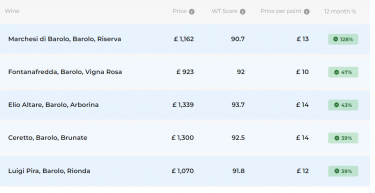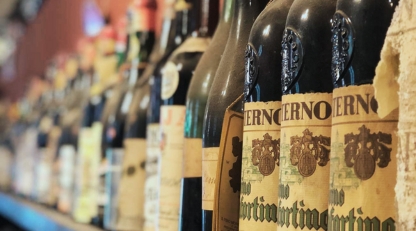- Italian fine wine has demonstrated resilience during the market’s latest corrective phase.
- Piedmont and Tuscany have shaped the Italian fine wine market in complementary ways.
- In the last year, Bibi Graetz Testamatta has been the best performing brand from Tuscany, up 93%, while Marchesi di Barolo Riserva has led the way in Piedmont, up 128%.
Italy has been a beacon of stability during the fine wine market’s latest corrective phase, which has seen prices fall 7.5% over the last year. The Italy 100 index has dipped just 0.4% during this time, but many of its top wine brands have continued to make considerable gains.
Italy’s stability is more than just a short-term trend; its long-term performance has been characterised by low volatility and steady returns. Its index has risen 286% in value over the last two decades, driven by growing demand for Italian fine wine, and quality improvements.
Indeed, the top wines of Piedmont and Tuscany compare favourably to Burgundy and Bordeaux in terms of critic scores, yet prices are often lower. Italy entices buyers with lower-cost access into the fine wine market, and the diversity of its offerings. On average, one can get a case of the top Super Tuscans (Tignanello, Sassicaia, Ornellaia) for £2,129; the First Growths (Mouton Rothschild, Haut-Brion and Margaux) cost more than double.
The complementary performance of Piedmont and Tuscany
Two major regions have played pivotal roles in shaping the Italian fine wine market in complementary ways: Piedmont and Tuscany.
Piedmont’s top wines, chiefly made from the native Nebbiolo grape, are produced in limited quantities, with rarity and exclusivity driving demand and prices. The dynamics behind the region’s performance evoke comparisons with Burgundy (and its signature Pinot Noir), where scarcity intensifies the allure. Historically, Piedmont has been the chief driver behind Italy’s rising prices.
Meanwhile, Tuscany has greatly contributed to cementing Italy’s place on the global fine wine stage, and its increasing market share. The brand strength of the Super Tuscans, combined with high quality, greater volumes and solid liquidity, have given the Italian market a significant boost.
The best performing brands in the last year
Piedmont

*Explore the performance of different wines on Wine Track, our comprehensive fine wine index that enables you to identify investment grade wines, spot trends and wine investment opportunities.
Marchesi di Barolo Barolo Riserva leads the way among Piedmont’s biggest risers, up an impressive 128% in the last year. However, the rest of the wines have made gains between 39% and 47%.
Tuscany

From Tuscany, Bibi Graetz Testamatta has seen the biggest rise in value in the last year, up 93%. The wine has an attractive point of entry, with an average case price of £1,530. Some of its best value vintages include 2011, 2012, 2015 and 2016. The 2021 vintage is expected to be released next month, as part of this autumn’s La Place de Bordeaux campaign.
The rest of Tuscany’s best performers have risen between 40% and 67%, with Antinori’s Guado al Tasso at the higher price end and Montevertine Rosso being the lowest priced.
The significant growth observed in individual brands from both regions accentuates Italy’s investment potential. Despite the recent bearish trend in the market, Italy has continued to deliver and attract greater demand.
WineCap’s independent market analysis showcases the value of portfolio diversification and the stability offered by investing in wine. Speak to one of our wine investment experts and start building your portfolio. Schedule your free consultation today.
